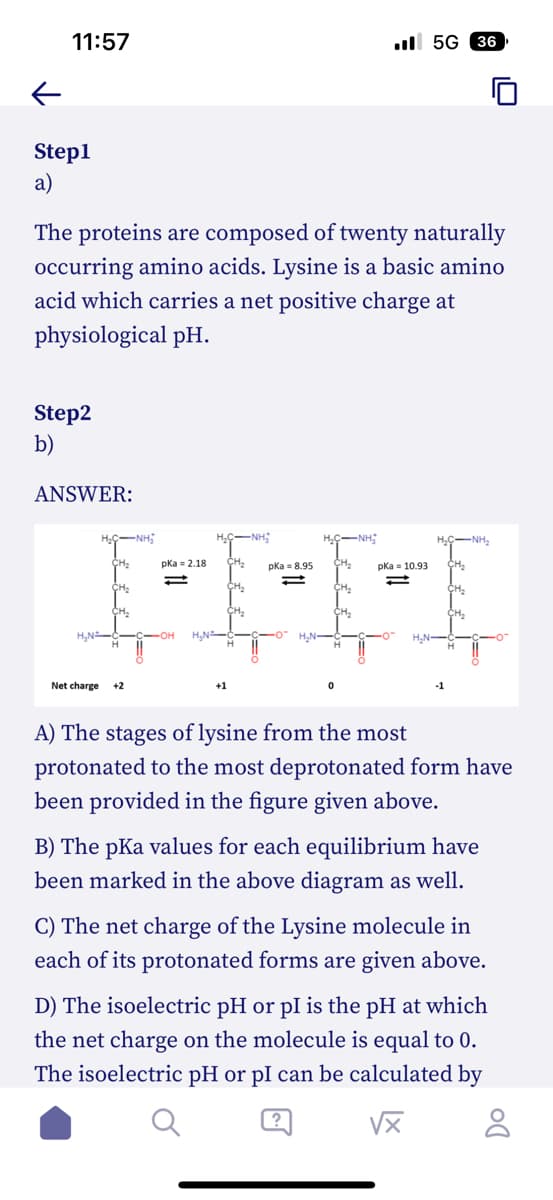) What would be the predominant ionization states of this amino acid at physiological pH (7.4) and at this pH, what would the ratio of these two states be (show the calculation)?
) What would be the predominant ionization states of this amino acid at physiological pH (7.4) and at this pH, what would the ratio of these two states be (show the calculation)?
Anatomy & Physiology
1st Edition
ISBN:9781938168130
Author:Kelly A. Young, James A. Wise, Peter DeSaix, Dean H. Kruse, Brandon Poe, Eddie Johnson, Jody E. Johnson, Oksana Korol, J. Gordon Betts, Mark Womble
Publisher:Kelly A. Young, James A. Wise, Peter DeSaix, Dean H. Kruse, Brandon Poe, Eddie Johnson, Jody E. Johnson, Oksana Korol, J. Gordon Betts, Mark Womble
Chapter2: The Chemical Level Of Organization
Section: Chapter Questions
Problem 43CTQ: If the disaccharide maltose is formed from two glucose monosaccharides, which are hexose sugars, how...
Related questions
Question
e) What would be the predominant ionization states of this amino acid at physiological pH
(7.4) and at this pH, what would the ratio of these two states be (show the calculation)?
![←
11:57
ANSWER:
H₂N
HIỆNhĩ
CH₂
CH₂
CH₂
Net charge +2
pka = 2.18
H.CNH:
CH₂
+1
CH₂
pka = 8.95
=
HỌC-NH:
CH₂
pl = (10.93 +8.95)/2
= 9.94 [Answer]
CH₂
pka 10.93
5G 36
√x
X
H₂N-
HNH,
CH₂
A) The stages of lysine from the most
protonated to the most deprotonated form have
been provided in the figure given above.
CH₂
B) The pKa values for each equilibrium have
been marked in the above diagram as well.
C) The net charge of the Lysine molecule in
each of its protonated forms are given above.
D) The isoelectric pH or pl is the pH at which
the net charge on the molecule is equal to 0.
The isoelectric pH or pl can be calculated by
taking an average of the pKa of the ionizable
groups that is undergoing dissociation and is
flanking the species with net charge = 0. As
shown in the above figure, the pl of Lysine will
be
CH₂
DO](/v2/_next/image?url=https%3A%2F%2Fcontent.bartleby.com%2Fqna-images%2Fquestion%2Fdee86e2c-9f58-4a27-8498-345972fbf5a2%2F052cc040-d64f-4b49-b48a-cf529ca08116%2Fqqapydp_processed.jpeg&w=3840&q=75)
Transcribed Image Text:←
11:57
ANSWER:
H₂N
HIỆNhĩ
CH₂
CH₂
CH₂
Net charge +2
pka = 2.18
H.CNH:
CH₂
+1
CH₂
pka = 8.95
=
HỌC-NH:
CH₂
pl = (10.93 +8.95)/2
= 9.94 [Answer]
CH₂
pka 10.93
5G 36
√x
X
H₂N-
HNH,
CH₂
A) The stages of lysine from the most
protonated to the most deprotonated form have
been provided in the figure given above.
CH₂
B) The pKa values for each equilibrium have
been marked in the above diagram as well.
C) The net charge of the Lysine molecule in
each of its protonated forms are given above.
D) The isoelectric pH or pl is the pH at which
the net charge on the molecule is equal to 0.
The isoelectric pH or pl can be calculated by
taking an average of the pKa of the ionizable
groups that is undergoing dissociation and is
flanking the species with net charge = 0. As
shown in the above figure, the pl of Lysine will
be
CH₂
DO

Transcribed Image Text:11:57
←
Step1
a)
The proteins are composed of twenty naturally
occurring amino acids. Lysine is a basic amino
acid which carries a net positive charge at
physiological pH.
Step2
b)
ANSWER:
HC-NHĨ
CH₂
CH₂
CH₂
H₂N (
Net charge +2
pka = 2.18
+1
CH₂
CH₂
pka = 8.95
H.ỆNH:
CH₂
CH₂
CH₂
pKa 10.93
5G 36
H₂N
HỌC NH,
CH₂
CH₂
A) The stages of lysine from the most
protonated to the most deprotonated form have
been provided in the figure given above.
B) The pKa values for each equilibrium have
been marked in the above diagram as well.
C) The net charge of the Lysine molecule in
each of its protonated forms are given above.
D) The isoelectric pH or pl is the pH at which
the net charge on the molecule is equal to 0.
The isoelectric pH or pl can be calculated by
√x
Expert Solution
This question has been solved!
Explore an expertly crafted, step-by-step solution for a thorough understanding of key concepts.
Step by step
Solved in 2 steps

Recommended textbooks for you

Anatomy & Physiology
Biology
ISBN:
9781938168130
Author:
Kelly A. Young, James A. Wise, Peter DeSaix, Dean H. Kruse, Brandon Poe, Eddie Johnson, Jody E. Johnson, Oksana Korol, J. Gordon Betts, Mark Womble
Publisher:
OpenStax College

Biology 2e
Biology
ISBN:
9781947172517
Author:
Matthew Douglas, Jung Choi, Mary Ann Clark
Publisher:
OpenStax

Anatomy & Physiology
Biology
ISBN:
9781938168130
Author:
Kelly A. Young, James A. Wise, Peter DeSaix, Dean H. Kruse, Brandon Poe, Eddie Johnson, Jody E. Johnson, Oksana Korol, J. Gordon Betts, Mark Womble
Publisher:
OpenStax College

Biology 2e
Biology
ISBN:
9781947172517
Author:
Matthew Douglas, Jung Choi, Mary Ann Clark
Publisher:
OpenStax